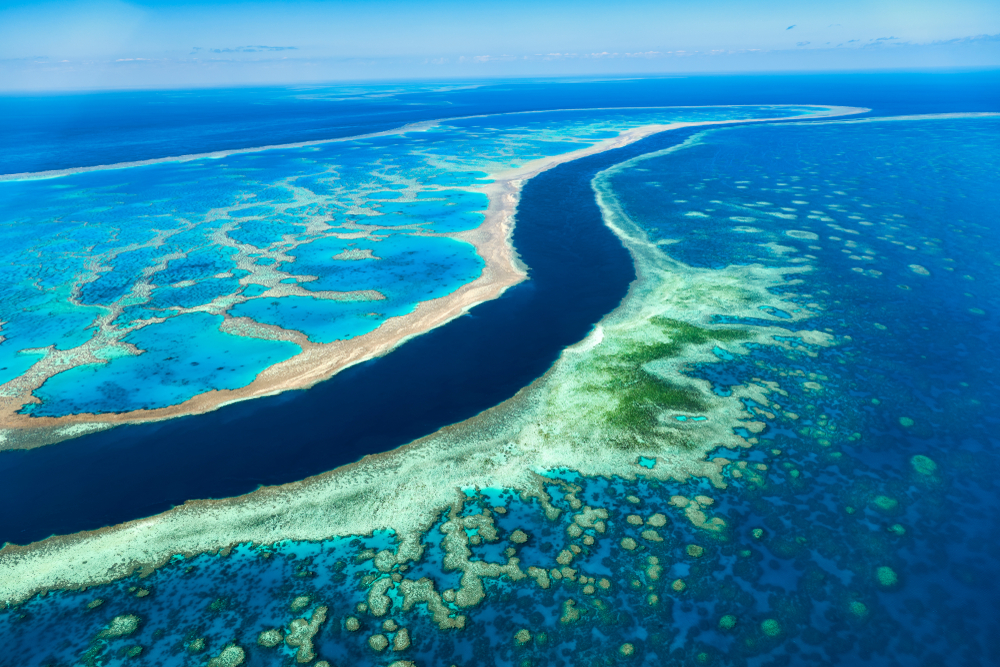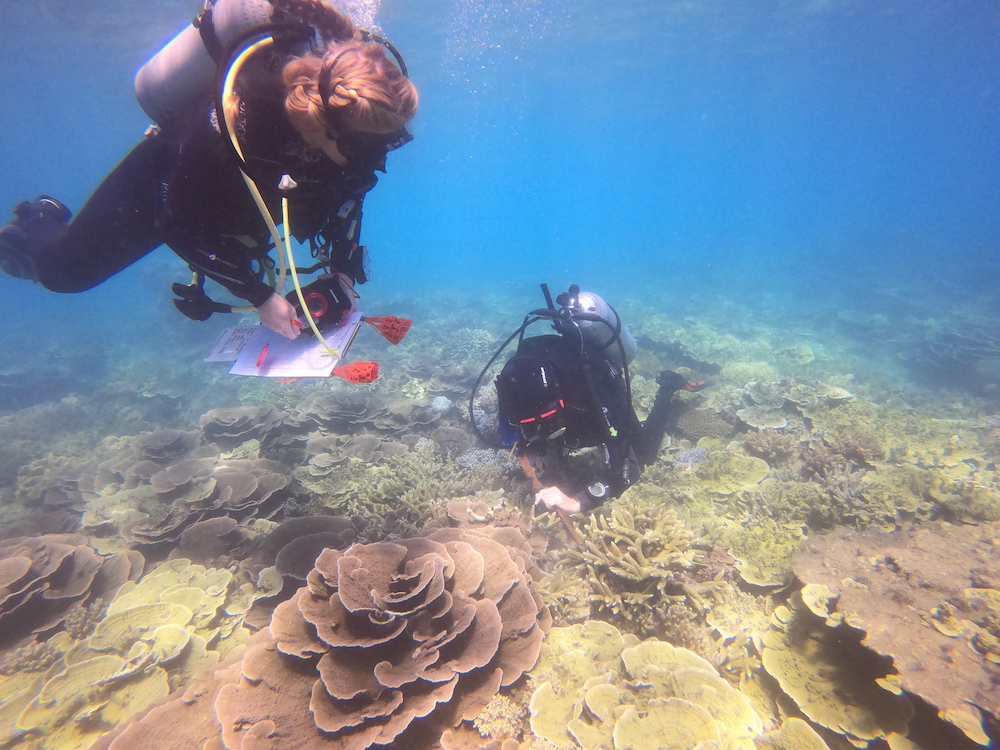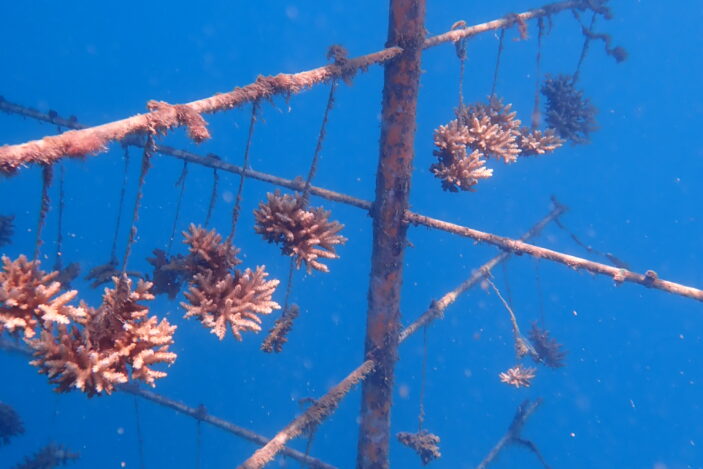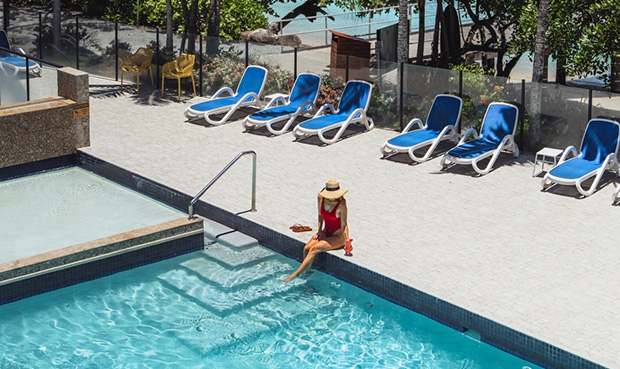Ever since its establishment in 2010, Fitzroy Island Resort has been a strong supporter of the movement to protect the Great Barrier Reef and all of its inhabitants. As a matter of fact, the very first step in coral restoration development happened right here on Fitzroy Island, with the help of our friends from the Turtle Volunteers and the Cairns Dive Centre.
Why the Reef Restoration Program was started
The Great Barrier Reef is under threat. When corals are stressed due to the changes in their living conditions (with regards to temperature, light, and nutrients), they expel the symbiotic algae that live in their tissues, causing them to turn completely white. This is a phenomenon called coral bleaching, which is mainly caused by rising ocean temperatures brought on by global warming, carbon pollution, and climate change.
There have been five major mass bleaching events in the last two decades, with the most recent one occurring just last year in 2020. The impact of coral bleaching is so horrific that it has the potential to wipe out whole ecosystems. With the corals left vulnerable and subject to mortality, the wildlife around is no longer able to find food. They’re forced to move elsewhere; in worst case scenarios, they end up dying. This results in barren underwater landscapes.
The purpose of our Reef Restoration Program is to create hope and change through tangible, breakthrough solutions in favor of instigating improvements to the state of the Great Barrier Reef. Our goals and efforts are all made possible by the Reef Restoration Foundation, a non-profit organization that grows and plants corals that are more resilient – starting of course at Fitzroy Island. This process mimics nature and allows damaged reefs to re-open faster, making them stronger.
The pilot project first began in December 2017, where we only had six coral growing trees. We have since expanded to 20 coral trees, totaling to more than 2000 growing corals! We’ve even out-planted over 300 trees back into the reef and believe us, we’re not about to stop anytime soon.
A beloved Australian wonder, the Great Barrier Reef is an integral part of our national identity. Naturally, we have all been deeply affected by the impact of the recent bleaching events. This is why we choose to take action through the Reef Restoration Program, where we work to establish coral nurseries that will become strong enough to regenerate degraded reefs.

Why is the Great Barrier Reef so important?
It forms barriers
Comprising 3,000 coral reefs, the Great Barrier Reef forms barriers for coastlines, acting as a buffer from the strong waves and storms that wash in from the open ocean. To put it into perspective, if the coral reefs were not there, several towns and cities would be victims of the harsh elements.
It provides habitats
If not for these reefs, there would be no homes for over 4000 types of mollusc, 1,500 species of fish, 100 species of sharks and rays, 30 species of whales and dolphins, 6 varieties of sea turtles, and not to mention, the more than 600 varieties of coral. It’s also famously the habitat of the dugong (‘sea cow’) and the large green turtle, both of which face the threat of extinction.
It contributes to medical research
Over the years, scientists have studied coral reefs in the interest of developing medicines that treat asthma, arthritis, heart disease, cancer, and more. This is done by isolating the chemical compounds found within the reef and using them to aid in the treatment of certain diseases. Scientists also study certain creatures like clams to further understand their aging process, as well as their antiviral and antibacterial properties.
It purifies the water
Most corals are filter feeders, which means they take the impurities from the sea and leave behind clearer, healthier waters. Without them, the seas would become a murky place constantly oozing sediment and particles that clouds the environment.
It slows down climate change
Coral reefs play an amazing and incredibly important role in our environment, as they recycle carbon dioxide from the atmosphere. When the algae on the corals naturally absorb the carbon dioxide from the air to use for photosynthesis, the coral polyps then feed upon the algae and deposit the carbon in the form of limestone. This builds up the rocky structure of the reef.
It’s used to track climates
Speaking of climates, scientists also rely on the corals to track the current state of global warming. Because some structures of the reef are possibly millions of years old, they are used in the study of ancient rock samples to pinpoint important climatic events over the past several thousand years.
It drives the economy
The Great Barrier Reef supports the direct employment of hundreds of thousands of people. The tourist industry alone annually generates around $6 billion for the Australian economy. With the vast amount of people relying on the reef for their income, the effect of it disappearing would be devastating, to say the least.

DCIM100GOPROGOPR4773.JPG
So how does the reef restoration program work?
With the help of scientists from James Cook University’s TropWATER and Reef Ecologic, as well as dozens of generous volunteers, corals are grown in the nurseries to regenerate the damaged high-value reefs.
We collect small amounts of healthy corals that have survived the last two years of bleaching incidents, which should be more resilient to higher water temperatures. They are then developed in an off-shore coral nursery on Fitzroy Island, where they grow significantly faster than they would on the reef.
After some time – usually six to twelve months – we take cuttings from each of the growing corals to plant on the reef. It’s there that the coral is able to grow and regenerate damaged sections of the reef which helps to reinforce strength overall.
The original corals are kept in the nurseries where they can regrow and the process becomes a continuous cycle. Through these simple steps, thousands of new corals can be created! It’s the exact same concept of taking cuttings from healthy plants in the garden and using them to grow new plants.
For the past thirty years, the act of coral restoration has helped damaged reefs from all around the world regenerate. And the reef restoration program has even had the honour to help work on successful coral restoration projects in Florida and the Caribbean to create the first-ever Great Barrier Reef nursery near Cairns.
Here’s how you can do your part to help
Even if you’re far away from the reef there are ways that you can help! Both individual and corporate coral crusaders are encouraged to help in accelerating the recovery of damaged coral reefs and enhancing their resilience, meaning they will be able to withstand the impacts of future catastrophes.
No matter where you are in the world, you can help the program by donating to the Reef Restoration program or Adopting a Coral. There are many different adoption options available to you, which you can learn about here.
Simply visiting Fitzroy Island resort can help contribute to the Reef Restoration, you are already giving to the foundation and thereby contributing to practical coral restoration projects. We’re a huge supporter of the Reef Restoration program, and we hold talks are help weekly at the Fitzroy Island Resort, where anyone can learn more about the impressive work that the foundation has been doing. We welcome schools to add us into their itinerary of field trips, as we would love to educate the youth more about the secret life of corals, the reef restoration project, the current state of the Great Barrier Reef, and what they can do to help!
Your involvement, no matter how small, will actively make a huge difference to the health of our Great Barrier Reef.





